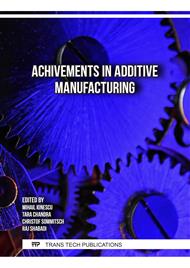p.109
p.117
p.123
p.129
p.135
p.143
p.151
p.157
p.163
Microstructural and Mechanical Characterization of Large Surfaces after Laser Cladding by Wavering of Nickel Coating on Cast-Iron Molds Used in Glass Industry
Abstract:
Laser cladding of a Ni based powder on cast iron is performed by a 4kW continuous diode laser. For this, a robot programming method named “Wavering” is used. Indeed, this method allows to cover large surfaces (width higher than 5 mm and thickness higher than 4 mm). The cast iron substrate used during this work is employed for its thermal properties in glass mold Industry. However, it has drawbacks which are weak wear, corrosion, and abrasion resistance. Conventional techniques used to protect the molds, like Plasma Transferred Arc (PTA), affect the molds microstructure, but also the thermal and mechanical properties. The laser cladding of the Ni based alloy allows to protect the molds without affecting the cast iron thermal properties (low Heat Affected Zone). The purpose of this research is to produce a well bonded Ni based melted powder without pores or cracks on large and curvilinear surfaces. First, the coating, adapted to this substrate geometry, is optimized. Then, an investigation of the impact of the processing parameters (power, scanning speed and wavering frequency) on the microstructure is carried out. Besides, the mechanical behaviour is analysed by microhardness. In addition, the evolution of the Heat Affected Zone (HAZ) according to the processing parameters is observed. Two kinds of areas are inspected in terms of microstructure: a stable area obtained after a single pass and an interferenced area linked to superimposed passes. Those analyses led to a cladding parameter optimization to obtain perfect bonding, to avoid porosity propagation and to limit the HAZ emergence on curvilinear surfaces. Finally, in comparison with the PTA technique, it appears that laser cladding process with wavering method leads to a good coating of curvilinear surfaces.
Info:
Periodical:
Pages:
151-156
Citation:
Online since:
November 2023
Keywords:
Price:
Сopyright:
© 2023 Trans Tech Publications Ltd. All Rights Reserved
Share:
Citation:



